外研社七年级英语教案
- 格式:docx
- 大小:11.50 KB
- 文档页数:7
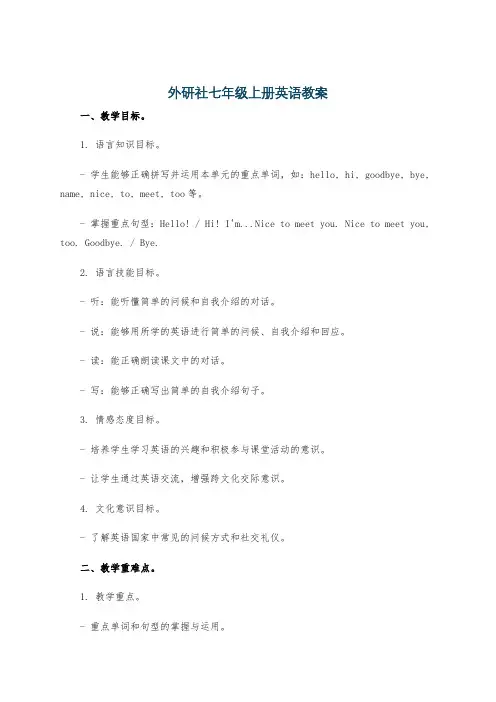
外研社七年级上册英语教案一、教学目标。
1. 语言知识目标。
- 学生能够正确拼写并运用本单元的重点单词,如:hello, hi, goodbye, bye, name, nice, to, meet, too等。
- 掌握重点句型:Hello! / Hi! I'm...Nice to meet you. Nice to meet you, too. Goodbye. / Bye.2. 语言技能目标。
- 听:能听懂简单的问候和自我介绍的对话。
- 说:能够用所学的英语进行简单的问候、自我介绍和回应。
- 读:能正确朗读课文中的对话。
- 写:能够正确写出简单的自我介绍句子。
3. 情感态度目标。
- 培养学生学习英语的兴趣和积极参与课堂活动的意识。
- 让学生通过英语交流,增强跨文化交际意识。
4. 文化意识目标。
- 了解英语国家中常见的问候方式和社交礼仪。
二、教学重难点。
1. 教学重点。
- 重点单词和句型的掌握与运用。
- 学生能够自信、流利地进行简单的英语问候和自我介绍。
2. 教学难点。
- 学生对Nice to meet you. 和Nice to meet you, too. 的理解与正确使用。
- 让学生克服害羞心理,积极参与口语交流活动。
三、教学方法。
1. 情景教学法。
通过创设各种真实的情景,如开学第一天的见面场景,让学生在情景中学习和运用英语。
2. 任务驱动法。
布置各种任务,如小组内互相问候、自我介绍并互相介绍给其他小组等任务,促使学生积极参与。
3. 交际教学法。
鼓励学生之间用英语进行交流互动,提高学生的英语口语表达能力。
四、教学过程。
1. 导入(5分钟)- 教师走进教室,用热情的笑容和手势引起学生的注意,然后用英语说:“Hello, boys and girls! I'm your English teacher today. My name is...”同时在黑板上写下自己的名字。
- 引导学生用Hello或Hi回应老师,并鼓励个别学生尝试说出自己的名字。

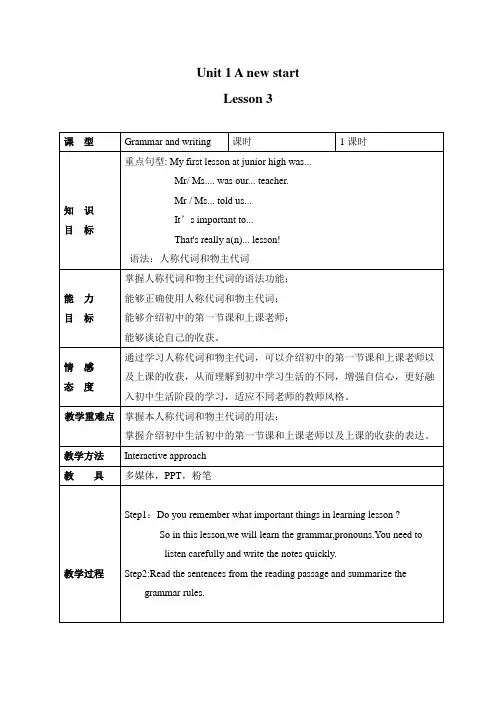
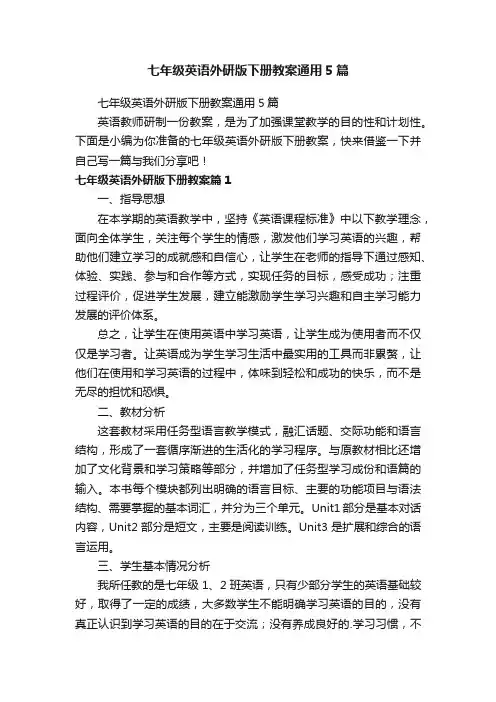
七年级英语外研版下册教案通用5篇七年级英语外研版下册教案通用5篇英语教师研制一份教案,是为了加强课堂教学的目的性和计划性。
下面是小编为你准备的七年级英语外研版下册教案,快来借鉴一下并自己写一篇与我们分享吧!七年级英语外研版下册教案篇1一、指导思想在本学期的英语教学中,坚持《英语课程标准》中以下教学理念,面向全体学生,关注每个学生的情感,激发他们学习英语的兴趣,帮助他们建立学习的成就感和自信心,让学生在老师的指导下通过感知、体验、实践、参与和合作等方式,实现任务的目标,感受成功;注重过程评价,促进学生发展,建立能激励学生学习兴趣和自主学习能力发展的评价体系。
总之,让学生在使用英语中学习英语,让学生成为使用者而不仅仅是学习者。
让英语成为学生学习生活中最实用的工具而非累赘,让他们在使用和学习英语的过程中,体味到轻松和成功的快乐,而不是无尽的担忧和恐惧。
二、教材分析这套教材采用任务型语言教学模式,融汇话题、交际功能和语言结构,形成了一套循序渐进的生活化的学习程序。
与原教材相比还增加了文化背景和学习策略等部分,并增加了任务型学习成份和语篇的输入。
本书每个模块都列出明确的语言目标、主要的功能项目与语法结构、需要掌握的基本词汇,并分为三个单元。
Unit1部分是基本对话内容,Unit2部分是短文,主要是阅读训练。
Unit3是扩展和综合的语言运用。
三、学生基本情况分析我所任教的是七年级1、2班英语,只有少部分学生的英语基础较好,取得了一定的成绩,大多数学生不能明确学习英语的目的,没有真正认识到学习英语的目的在于交流;没有养成良好的.学习习惯,不能做好课前预习课后复习,不善于发现和总结语言规律,不注意知识的巩固和积累。
四、具体措施1、每天背诵课文中的重点对话。
目的:要求学生背诵并默写英语句子,培养学生良好的英语语感。
2、每天听写本节课中需要用到的重点生词,常用句子或习语。
利用“互测及教师抽查”及时检查,保证效果并坚持下去。
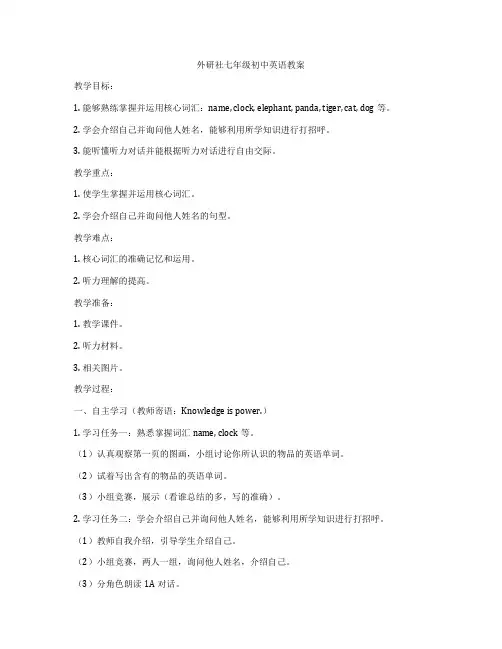
外研社七年级初中英语教案教学目标:1. 能够熟练掌握并运用核心词汇:name, clock, elephant, panda, tiger, cat, dog等。
2. 学会介绍自己并询问他人姓名,能够利用所学知识进行打招呼。
3. 能听懂听力对话并能根据听力对话进行自由交际。
教学重点:1. 使学生掌握并运用核心词汇。
2. 学会介绍自己并询问他人姓名的句型。
教学难点:1. 核心词汇的准确记忆和运用。
2. 听力理解的提高。
教学准备:1. 教学课件。
2. 听力材料。
3. 相关图片。
教学过程:一、自主学习(教师寄语:Knowledge is power.)1. 学习任务一:熟悉掌握词汇name, clock等。
(1)认真观察第一页的图画,小组讨论你所认识的物品的英语单词。
(2)试着写出含有的物品的英语单词。
(3)小组竞赛,展示(看谁总结的多,写的准确)。
2. 学习任务二:学会介绍自己并询问他人姓名,能够利用所学知识进行打招呼。
(1)教师自我介绍,引导学生介绍自己。
(2)小组竞赛,两人一组,询问他人姓名,介绍自己。
(3)分角色朗读1A对话。
3. 学习任务三:能听懂听力对话并能对根据听力对话进行自由交际。
(1)听录音,给1B的对话编号。
(2)根据听力对话进行自由交际。
(3)小组竞赛,展示对话交际。
二、合作共建(教师寄语:Many hands make light work.)1. 小组讨论我们所学的英语名字和汉语名字的区别,如何用英语拼写。
2. 小组成员互相介绍,练习使用所学词汇和句型。
三、课堂巩固1. 教师挑选几位学生,让他们在黑板上写出本节课所学的词汇。
2. 教师随机抽取学生,让他们用所学的句型进行自我介绍。
四、课后作业1. 抄写本节课所学的词汇,每个词汇写5遍。
2. 复习本节课所学的句型,并尝试与家人或朋友进行英语交流。
教学反思:本节课通过自主学习、合作共建和课堂巩固等环节,使学生掌握了核心词汇,学会了介绍自己并询问他人姓名的句型。
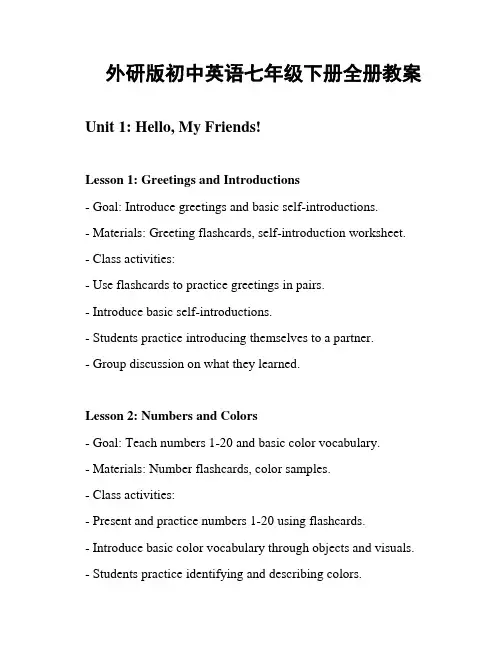
外研版初中英语七年级下册全册教案Unit 1: Hello, My Friends!Lesson 1: Greetings and Introductions- Goal: Introduce greetings and basic self-introductions.- Materials: Greeting flashcards, self-introduction worksheet. - Class activities:- Use flashcards to practice greetings in pairs.- Introduce basic self-introductions.- Students practice introducing themselves to a partner.- Group discussion on what they learned.Lesson 2: Numbers and Colors- Goal: Teach numbers 1-20 and basic color vocabulary.- Materials: Number flashcards, color samples.- Class activities:- Present and practice numbers 1-20 using flashcards.- Introduce basic color vocabulary through objects and visuals. - Students practice identifying and describing colors.- Reinforce learning with a color-matching game.Unit 2: My Family and My HomeLesson 1: Family Members- Goal: Learn how to talk about family members in English.- Materials: Family tree diagram, family member flashcards.- Class activities:- Introduce family member vocabulary using flashcards.- Present a family tree diagram and discuss relationships.- Practice asking and answering questions about family members. - Students create their own family tree diagrams.Lesson 2: My Home- Goal: Describe rooms and furniture in a house.- Materials: House diagram, furniture flashcards.- Class activities:- Introduce vocabulary for different rooms and furniture items. - Present a house diagram and label the rooms.- Students practice describing their own homes.- Group activity: Designing their dream house using English vocabulary.Unit 3: My School LifeLesson 1: School Subjects- Goal: Introduce school subject vocabulary.- Materials: Subject flashcards, timetable template.- Class activities:- Present and practice vocabulary for school subjects.- Introduce a typical school timetable.- Students create their own timetables and discuss with partners.- Group activity: Role-play a school day schedule.Lesson 2: School Facilities- Goal: Learn vocabulary for different facilities in a school.- Materials: School map, facility flashcards.- Class activities:- Introduce a school map and label the facilities.- Students describe their school environment.- Group activity: Design an ideal school using English vocabulary.Unit 4: Hobbies and InterestsLesson 1: Hobbies- Materials: Hobby flashcards, hobby survey worksheet.- Class activities:- Present and practice vocabulary for different hobbies.- Small group activity: Creating a poster about their favorite hobby.Lesson 2: Sports and Activities- Goal: Learn vocabulary related to sports and activities.- Materials: Sports flashcards, activity pictures.- Class activities:- Present and practice vocabulary for different sports and activities.- Students describe their favorite sports and activities.- Pair activity: Role-play a conversation about planning a weekend activity.- Group activity: Creating a sports and activities collage.Unit 5: Daily RoutineLesson 1: Daily Activities- Materials: Daily routine flashcards, daily routine chart.- Class activities:- Present and practice vocabulary for daily activities.- Students fill in their daily routine charts and share with partners.- Pair activity: Role-play a conversation about daily activities.Lesson 2: Telling Time- Goal: Learn how to tell time in English.- Materials: Clock flashcards, time worksheets.- Class activities:- Introduce vocabulary for different times on the clock.- Practice telling time using flashcards and worksheets.- Pair activity: Role-play a conversation about scheduling activities.- Group activity: Creating a daily schedule using English vocabulary.。
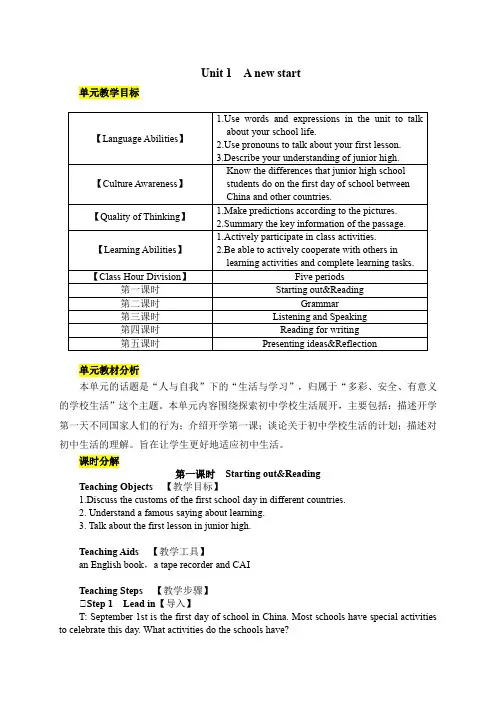
Unit 1 A new start单元教学目标单元教材分析本单元的话题是“人与自我”下的“生活与学习”,归属于“多彩、安全、有意义的学校生活”这个主题。
本单元内容围绕探索初中学校生活展开,主要包括:描述开学第一天不同国家人们的行为;介绍开学第一课;谈论关于初中学校生活的计划;描述对初中生活的理解。
旨在让学生更好地适应初中生活。
课时分解第一课时Starting out&ReadingTeaching Objects【教学目标】1.Discuss the customs of the first school day in different countries.2. Understand a famous saying about learning.3. Talk about the first lesson in junior high.Teaching Aids【教学工具】an English book,a tape recorder and CAITeaching Steps【教学步骤】★Step 1Lead in【导入】T: September 1st is the first day of school in China. Most schools have special activities to celebrate this day. What activities do the schools have?Ss:For example, have the school opening ceremony, have the flag-raising ceremony, watch the program The First Lesson produced by CCTV, have some welcome performances.Starting outPage 15,11.Ask the Ss to discuss the question: What do people do on the first day of school inRussia/ Indonesia/ France/ the USA?2.Show the four sentences on page 15 to the Ss and make sure they understand the meaning of these sentences.3.Ask the Ss to guess and match the sentences with the countries.4.Check the answers with the class.Page 15,21.Ask the Ss to answer the question: What is junior high school life like?2.Let the Ss list something about what junior high school life is like.3.Ask the Ss to complete the table.Understanding ideas(1-4)★Step 2 Pre-task【准备任务】Page 16,11.Show the questionnaire to the Ss.2.Ask the Ss to answer the following questions.①What was your first lesson at junior high?②What did you do in that lesson?③What do you think is important in learning the lesson?3.Let the Ss complete the questionnaire.Page 16,2Ask the Ss to look at the picture and the title, and then ask them to discuss the following questions.①What was the writer’s first lesson at junior high?②What did the writer do in that lesson?★Step 3 While-task【过程任务】Page 16,21.Let the Ss read the passage and answer the question: What did the writer do in his first lesson?2.Ask some students to say their answers.3.Check the answers with the class.Page 18,31.Ask the Ss to read the passage again and choose the main idea of the passage.2.Check the right answer with the class.3.Tell the way to summarize the main idea of a passage.Page 18,41.Let the Ss complete the summary with the words and expressions from the passage.2.Ask some students to say their answers.3.Check the answers with the class.★Step 4 Post-task【后续任务】Page 18,Think and share1.Ask the Ss to think about the following question.What is the meaning of the sentence from Confucius?2.Give the Ss some prompts. For example, Who did Confucius say the sentenceto? Why did he say it? What do you think about learning and thinking?3.Choose some Ss to share their answers.4.Ask the Ss to think about the following question:Do you know other famous sayings about learning?5.Let some students share their answers.6.Make appropriate supplements according to students’ share.For example, thinking without studying is useless;Reading without understanding is like chewing bark;Skill comes from diligent practice, and neglect results come from idleness;A journey of a thousand miles begins with a single step.★Step 5Language points【语言要点】1. mistake的用法mistake 作名词,意为“错误;失误”。
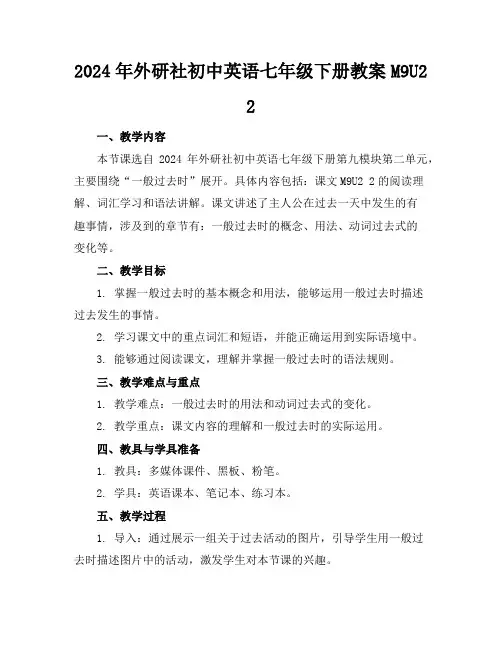
2024年外研社初中英语七年级下册教案M9U22一、教学内容本节课选自2024年外研社初中英语七年级下册第九模块第二单元,主要围绕“一般过去时”展开。
具体内容包括:课文M9U2 2的阅读理解、词汇学习和语法讲解。
课文讲述了主人公在过去一天中发生的有趣事情,涉及到的章节有:一般过去时的概念、用法、动词过去式的变化等。
二、教学目标1. 掌握一般过去时的基本概念和用法,能够运用一般过去时描述过去发生的事情。
2. 学习课文中的重点词汇和短语,并能正确运用到实际语境中。
3. 能够通过阅读课文,理解并掌握一般过去时的语法规则。
三、教学难点与重点1. 教学难点:一般过去时的用法和动词过去式的变化。
2. 教学重点:课文内容的理解和一般过去时的实际运用。
四、教具与学具准备1. 教具:多媒体课件、黑板、粉笔。
2. 学具:英语课本、笔记本、练习本。
五、教学过程1. 导入:通过展示一组关于过去活动的图片,引导学生用一般过去时描述图片中的活动,激发学生对本节课的兴趣。
2. 阅读理解:让学生阅读课文M9U2 2,理解并掌握课文内容。
教师针对课文中的重点词汇、短语和语法进行讲解。
3. 例题讲解:讲解一般过去时的用法和动词过去式的变化规则,结合实例进行分析。
4. 随堂练习:设计一些关于一般过去时的练习题,让学生当堂完成,巩固所学知识。
5. 小组活动:组织学生进行小组讨论,运用一般过去时描述自己过去一天中发生的有趣事情,提高学生的实际运用能力。
六、板书设计1. 一般过去时的概念和用法2. 动词过去式的变化规则3. 课文M9U2 2的重点词汇和短语七、作业设计1. 作业题目:请运用一般过去时,描述你过去一天中发生的有趣事情。
2. 答案示例:Yesterday, I got up at 7:00. Then I had breakfast and went to school. In the morning, I had anEnglish class. After lunch, I played football with my friends. In the evening, I watched TV and did my homework.八、课后反思及拓展延伸1. 反思:本节课学生对一般过去时的掌握情况,以及对课文内容的理解程度。
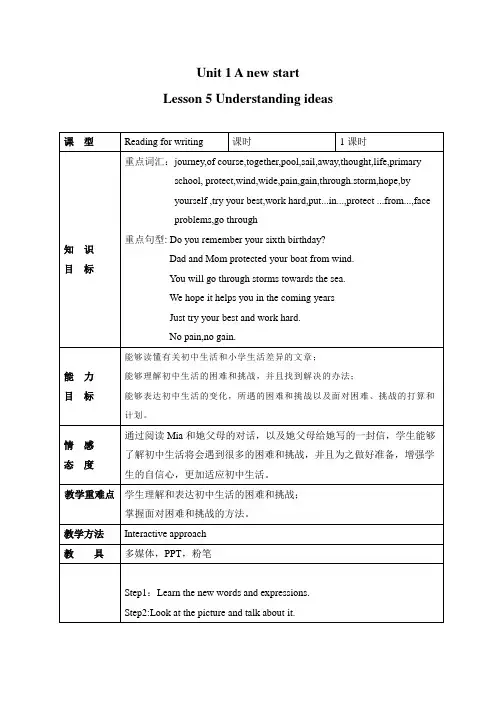
Unit 1 A new start Lesson 5 Understanding ideas教学过程教学过程How many people are there in the picture? Who are they?What do the parents give the girl?Step3:What can you do with a boat?Look at the picture,talk about what we meet.Look at the word and expressions and look up their meanings in adictionary.Studying at junior high is a journey.Let’s explore it.Step4:Reading the conversation and find out the meaning of the title.What is “journey”?What is the meaning of the title?Step5:Reading the conversation and answer these questions.( 1 ) What is their letter for?(2 )Is it the first paper boat from her parents?( 3 ) Did she remember (to have an idea ofsomething in one's mind) the first paper boat?( 4)What did they do with the first paperboat?Step6:Before reading the passage ,look at the timeline.Now,read the passage and complete the timeline.Step7:Complete the thinking map with the words and expressions from the passage.Step8:Answer the questions.1.What do “a pool”,”a river”and “the sea”stand for?2.What do you think Mia’s parents did protect her boat from wind?。

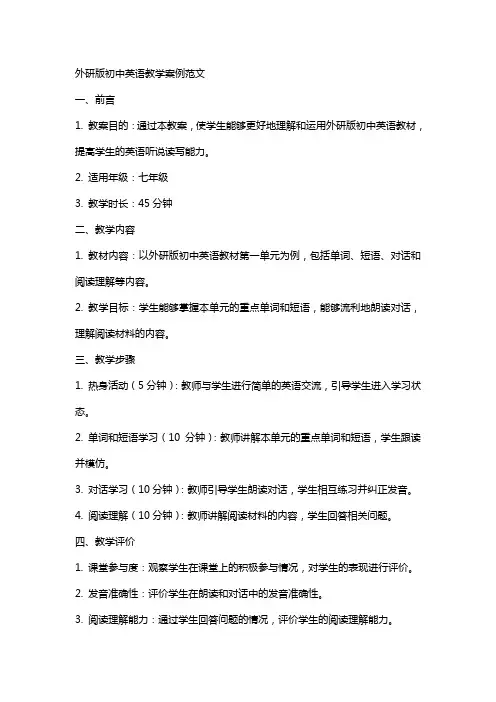
外研版初中英语教学案例范文一、前言1. 教案目的:通过本教案,使学生能够更好地理解和运用外研版初中英语教材,提高学生的英语听说读写能力。
2. 适用年级:七年级3. 教学时长:45分钟二、教学内容1. 教材内容:以外研版初中英语教材第一单元为例,包括单词、短语、对话和阅读理解等内容。
2. 教学目标:学生能够掌握本单元的重点单词和短语,能够流利地朗读对话,理解阅读材料的内容。
三、教学步骤1. 热身活动(5分钟):教师与学生进行简单的英语交流,引导学生进入学习状态。
2. 单词和短语学习(10分钟):教师讲解本单元的重点单词和短语,学生跟读并模仿。
3. 对话学习(10分钟):教师引导学生朗读对话,学生相互练习并纠正发音。
4. 阅读理解(10分钟):教师讲解阅读材料的内容,学生回答相关问题。
四、教学评价1. 课堂参与度:观察学生在课堂上的积极参与情况,对学生的表现进行评价。
2. 发音准确性:评价学生在朗读和对话中的发音准确性。
3. 阅读理解能力:通过学生回答问题的情况,评价学生的阅读理解能力。
教师在课后对自己的教学进行反思,分析教学中的优点和不足,不断改进教学方法,提高教学质量。
六、教学策略1. 互动式教学:通过问答、小组讨论等形式,引导学生主动参与课堂,提高学生的口语表达能力。
2. 情境教学:创设真实的语言环境,使学生在实际情境中学习英语,提高学生的实际应用能力。
3. 任务型教学:通过完成具体的任务,让学生在实践中学习和运用英语,提高学生的综合语言能力。
七、教学资源1. 教材:外研版初中英语教材2. 多媒体教学设备:投影仪、电脑、音响等3. 教学课件:根据教学内容制作的课件4. 网络资源:相关英语学习网站、在线视频等八、教学活动1. 单词游戏:通过单词接龙、猜单词等游戏,让学生在轻松愉快的氛围中学习单词。
2. 角色扮演:学生分组进行角色扮演,模拟真实场景,提高学生的口语表达能力。
3. 小组竞赛:分组进行听力、阅读、写作等竞赛,激发学生的学习兴趣和竞争意识。
外研社版的七年级英语教案5篇外研社版的七年级英语教案1教学目标Teaching aims(教学目标)1.学会谈论自己和他人过去发生的事情和活动。
2. 能够熟练的运用本节课出现的动词短语。
教学重难点Language points(语言点)1.要求掌握以下句式: Where did you go on vacation?I went to the mountains.2.要求掌握以下词汇:动词词组(过去式形式):went on vacation, stayed at home, went to the beach, went to the mountains, visited my uncle, went to summer camp, visited museums, went to New York City(本节课短语比较多,过去式变化也不简单,鼓励学生说出更多自己知道的描述过去事情的短语。
)Difficulties(难点):用准确的过去式短语描述过去发生的事情教学过程Teaching steps(教学步骤)1. Warm-up and lead in(课堂热身和导入)(1)New term greetings (新学期问候)T: Hello everyone! Good to see all of you again. Did you enjoy your summer vacation?S: Yes!(师生之间的问好过后,让学生前后位、同桌之间互相问好)(2)Lead in(导入)T: Can you tell me about the activities you did during the summer vacation? Try to use verb phrases, for example, “watch TV”.S1: I went shopping.S2: I went to the movies with my friends.S3: I went swimming.(老师可以鼓励学生给出尽可能多的答案,并引导学生使用过去式)T: Wow. It sounds like you had a good time during the summer vacation! I’m sure you enjoyed yourselves very much. Now I want to know where you went on vacation.(教师把“Where did you go on vacation?”和 I went/…板书在黑板上) 教学设计说明:从贴近学生熟悉的话题入口,通过对学生暑假生活的了解及回顾,引出今天的重点内容。
课题外研版七年级上册Unit 1 A New Start Developing Ideas 讲义一、教学目标1. 知识目标学生能够听懂与学校生活和学习计划相关的听力材料。
掌握并运用与学习计划和问题相关的词汇和句型。
2. 技能目标通过听力练习,提高学生获取关键信息和细节的能力。
能够运用所学语言,就学习计划中的问题进行交流并给出建议。
培养学生合作学习和沟通的能力。
3. 情感目标激发学生对新学习生活的积极态度和热情。
增强学生解决学习中问题的信心和能力。
二、教学重难点1. 教学重点掌握重点词汇,如:schedule, challenge, solution 等。
理解并准确获取听力材料中的关键信息。
能够运用所学句型就学习计划的问题进行交流和建议。
2. 教学难点对较复杂的听力内容的理解和把握。
如何引导学生用恰当的语言和逻辑给出有效的学习计划建议。
三、教学方法1. 任务型教学法:通过布置各种任务,让学生在完成任务的过程中学习和运用语言。
2. 情景教学法:创设与学校生活和学习计划相关的情景,让学生在真实的语境中感受和运用语言。
3. 合作学习法:组织学生进行小组合作,共同完成听力、讨论和交流等活动,培养合作能力。
四、教学过程(一)导入(5 分钟)1. 教师通过展示一些关于新学校、新学习生活的图片或视频,引起学生的兴趣,引导学生回忆和分享自己在新学校的感受和经历。
2. 提问学生在新的学习生活中可能会遇到哪些问题,以及如何解决这些问题,从而引出本节课的主题——学习计划和问题解决。
(二)听力练习1(15 分钟)1. 教师播放第一遍录音,要求学生认真听,选择听力材料的主要意思。
提供三个选项,让学生在听完后进行选择。
听完后,邀请学生分享他们的选择,并简单说明理由。
2. 教师播放第二遍录音,让学生再次听,完成相关的海报内容。
给学生一定时间,独立完成海报的填写。
完成后,小组内进行交流和核对答案。
请几个小组代表展示他们的答案,教师进行点评和纠正。
外研社七年级英语教案【篇一:外研版七年级英语上册教案】教案教案教案教案【篇二:外研版七年级英语上教案全部】教案教案【篇三:外研版新版七年级英语下全册教案】module 1 lost and foundunit 1 whose bag is this?i. 课时 1课时ii. type of lesson: listening and speakingiii. teaching aims:i. knowledge aim: 学习和掌握名词性物主代词ii. ability aim: 能听懂有关失物招领的对话并表演在失物招领处发生的事情iii. emotion aim: 学会与他人交流时言行举止大方得体,对他人提供的帮助表示感谢 iv. teaching important and difficult pointsi. teaching important points: make the students understand and use the dialogueii. teaching difficult points: make sure the students can use the dialoguev. teaching aids: multi-media tape , recordervi. teaching procedurestep 1 lead-inuse a pen that was lost last term and ask whose pen is this? purpose: make the students interested in the topicstep 2 learning the dialoguei. learn the new wordsactivity1 match the words from the box with the pictures同步练习:--20 yuan.--__________________ the money.2. ______________, finish your homework after you get home.3. everyone, please ______________ your things when you take a bus.4. i’m your new english teacher ______________.5. everyone, please _______________ the pictures____________ the right thingsii. listen and readlisten to the tape and read the dialogueiii. match the people with the thingsiv. explain the language pointsms li: welcome back to school, everyone! first of all, come and look in the lost and found box! there are a lot of things in it. whose bag is this?lingling: oh sorry! it’s mine. are my crayons there too?ms li: are these crayons yours?lingling: yes, they are and this eraser too. thank you.ms li: whose tapes are these?daming: they’re mine.ms li: here’s purple wallet!tony: it’s mine. look! here’s my name ―tony‖! thank you.ms li: you’re welcome! look at this nice watch. is it yours too, daming?daming: no, it isn’t. i think it’s betty’s.1lingling: yes, it’s hers.ms li: everyone, please be careful with your things from now on.daming: here are some nice gloves. whose gloves are they? ms li: let me see. …oh, they’re mine. thank you!v. activity 4 and activity 5step 3 making the dialogue (activity 7)work in groups of three, put four or five school things on the desk, ask and answer.step 4 pronunciationstep 5 sum up and exercise1. --________ car in front of the office is it?--i think it’s mr green’s. he drives the car to work every day.a. whob. whosec. howd. what2. –what is the time now?--let me look at my _________. oh, it’s nine o’clock.a. numberb. planc. watchd. camera3. –is this your english book, amy?--no. __________ is in my schoolbag.a. mineb. myc. med. i4. –how can we stay healthy?-- _________, we should eat healthy food and take exercise every day.a. as well asb. first of allc. at the momentd. in a minute5. –mike, here __________ some letters for you.--thank you. they are from my american pen friend john.a. isb. bec. ared. were6. where is simon? his mother is __________ him now.a. looking atb. looking forc. findingd. finding out7. when you ___________ things, you can go to the lost and found office in our city.a. loseb. buyc. getd. sell8. –david, is this your sister’s doll?-- yes, it’s _________. she plays with it every day.a. herb. hisc. hersd. shestep 6: homeworkvii. blackboard writingmodule 1 lost and foundunit 1 whose bag is this?whose first of allmymine lose lost and found box ourours find be careful with your yours from now on your yours here is/areherhers hishisits its their theirs 2viii. 反思unit 2 are they yours?i. 课时 2课时(课文讲解练习)ii. type of lesson: reading and writingiii. teaching aims:iv. knowledge aim: 学习和掌握新单词v. ability aim: 能读懂有关失物招领的短文,能写出一则招领启事vi. emotion aim: 学会与他人交流时言行举止大方得体,对他人提供的帮助表示感谢 iv. teaching important and difficult pointsi. teaching important points: make the students understandthe passageii. teaching difficult points: make sure the students can find some useful information from the passage and write a lost and found note.v. teaching aids: multi-media tape , recordervi. teaching procedurestep 1 pre-readinglearn the new words and show the students a lost and found note, lead in the passage.step 2 while-readingactivity 1: listen and read the passage.activity 2: read the passage and answer the questions.1. when do people often lose things?2. why are there lost and found offices at airports and stations?3. what do people do at the lost and found office?4. what strange things are there at the new york city lost and found office?activity3: translate and explain the language pointsthe lost and found office in new york citywelcome to new york city lost and found office. people often lose things when they’re travelling or when they’re in a hurry. they leave things on planes, on trains, on buses and in taxis. that’s why there are lost and found offices at airports and stations.the new york city lost and found office is very big. hundreds of people come here every day. they are looking for their phones, cameras, watched, computers and many other things. we usually have about two thousand mobile phones and one thousand cameras.at the moment, there are also some strange things at new york city lost and found office. there are about a hundred bikes and a large boat. there are also a lot of animals. this week, there are three dogs, two ducks and a pig! whose are they? are theyyour s? we don’t know! are your looking for fifteen kilos of sausages? they’re here too!activity 4: complete the passage with the correct form of the words and expressions from the box. (activity3 on p5)step 3 post-readingwriting (activity 4 on p5)step 4 sum up and exercisea. 完成句子1、人们在旅行时或是匆忙时经常丢东西。